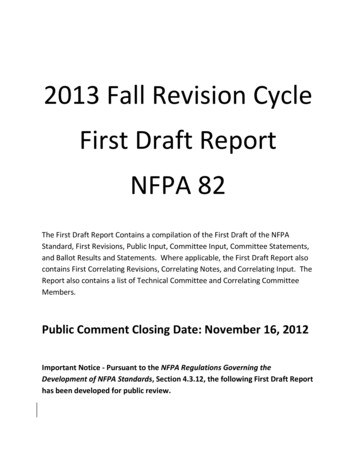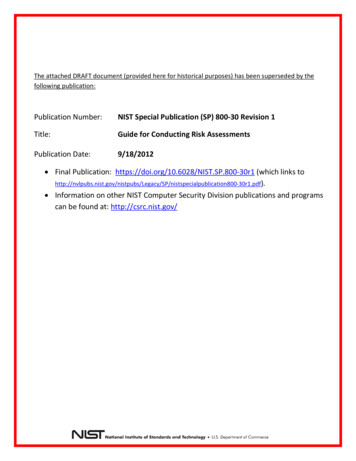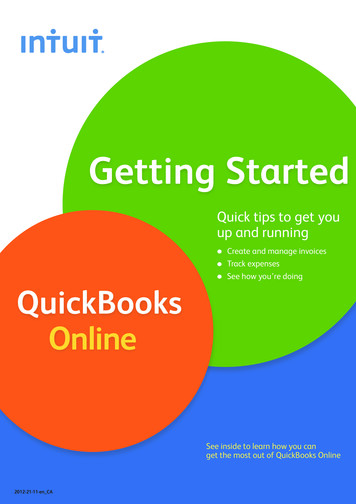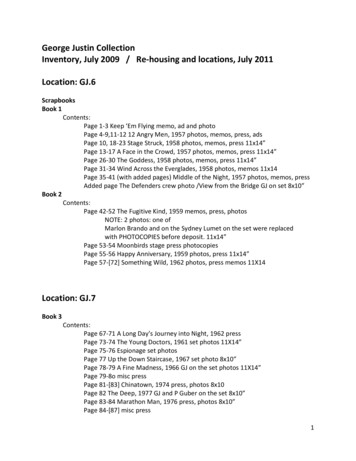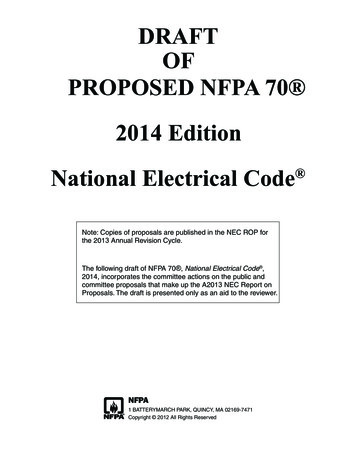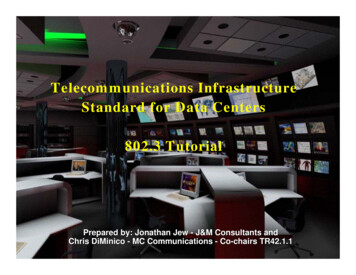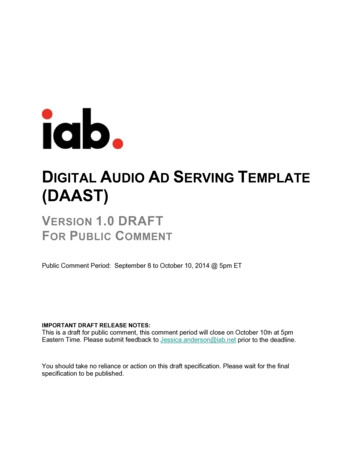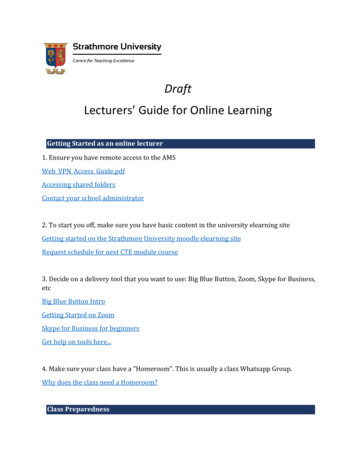
Transcription
DraftLecturers’ Guide for Online LearningGetting Started as an online lecturer1. Ensure you have remote access to the AMSWeb VPN Access Guide.pdfAccessing shared foldersContact your school administrator2. To start you off, make sure you have basic content in the university elearning siteGetting started on the Strathmore University moodle elearning siteRequest schedule for next CTE module course3. Decide on a delivery tool that you want to use: Big Blue Button, Zoom, Skype for Business,etcBig Blue Button IntroGetting Started on ZoomSkype for Business for beginnersGet help on tools here.4. Make sure your class have a "Homeroom". This is usually a class Whatsapp Group.Why does the class need a Homeroom?Class Preparedness
i)Before you begin, do a quick sound check to ensure that your audience can hearyou.ii) Ensure everyone has the latest class ID and keep checking on other social mediaplatforms the group may be on to see the pre-class behavior. There may bepeople locked out or struggling with their devices.iii) Spell out any rules you may have so that you have an orderly class, if possible, onother platforms like WhatsApp. E.g. if you are using Zoom, encourageparticipants to request to speak rather than interrupt a conversation.iv) Familiarise yourself with the technology beforehand to avoid fiddling aroundwith equipment during a session.v) Be flexible with some of the rules that do not interfere with the flow of thesession- for example, some participants may not want their video on.vi) Make sure you have all your essentials together – notes, marker pens, visuals etc.vii) It is good practice to share the learning outcomes of a session pinned on phonebased platforms and encourage students to keep referring to them.viii) Remember to ensure that the usual requirements of the university and yourrespective school are met. E.g. ensure that students have their course outlineswith updated course material in advance, teaching schedule etc.ix) Be prepared for the class. Remember that online classes cannot carry as muchcontent as a physical class as the chances of losing the student are even higher.Class handlingi)ii)iii)iv)v)vi)In a relatively small class, you can have a quick rollcall. Keep referring to thestudents by name.Teach in a quiet place to avoid feedback on the microphone.Consider other ways of engaging students outside the session so that theycontinue learning beyond the online session.Make use of different platforms and be flexible on the options in order to be asinclusive of many students as possible. For example, post guiding questions ofproblems on email, e-learning and one other platform accessible to students.Be present and take care of the students’ wellbeing. For example take note of anunusually quiet student and encourage post classroom feedback from students.Be creative:a. In your teaching during the session. There are many resources online thatcan help you learn how to blend your online session.b. In giving feedback during and after the session. In a large class, for example,record audio feedback for students to work on or think about.c. In assessment - whether it is formative or summative.d. In encouraging discourse amongst students – do not be the only one talking.
Cyber securityi)Ensure that you check the settings on the platform you are using so that you as thehost have rights to invite participants and can remove participants you deem to bedistractive to the group.ii) Enable the virtual waiting roomiii) Require meeting ID and passwordiv) Ensure that you are the punctual arriving some time before the session so that youcan invite participants.v) Students must always to use their real names rather than pseudo namesvi) Students and lecturer to use real profile photos rather than avatorsvii) Depending on the platform, disable any settings that may cause trouble. Settingsthat allow screen and file sharing should be disabled by default and require yourpermission. NB. Do not disable too many functions such that your studentsbecome totally passive listeners.viii) Do not allow removed participants to come back without your consent.ix) Regularly check the list of participants and call them by their names during thesessionOnline teaching etiquettei) As far as possible you want to reproduce the Strathmore University learningenvironment into the virtual class. This means always using branded materials,protocols, guidelines, in line with all existing policies.ii) Dress only as you would in a Strathmore face-to-face class.iii) Use only formal language types that you would use in a Strathmore face-to-faceclass.iv) Be careful about the non-verbal language you exhibit.v) Microphones should be kept off by default. Microphones catch even subtle, andotherwise annoying behavior like clearing one’s throat.vi) It is courteous to open and closing sessions formally. Use video at least at start andend, and require students who are able to do so to. Video improves the socialatmosphere and helps the learning process, but balance it off with data flow andbandwidth limitationsvii) Record your class and let the students know.Helping your students prepare for class – points of emphasis
i) It is easy to lose focus during an online class. Prepare your mind to focus wellbefore class beginning with yourself and then the students. Use the whatsappgroup to notify the students of the upcoming session’s learning outcomes,expectations, preparations, etcii) Gather any stationery or class material you would need. Files that will be screenshared should be ready on the screens.iii) Require students to have sent you in advance all materials, individual/groupassignments that they will screen shareiv) Prepare for your readings should the class have any.v) Class becomes much more interesting when the students are engaged. Askstudents to read your materials, to fill in gaps, for obvious statements andconclusions ask questions instead of saying it yourself. Prepare your questionsbeforehand.vi) Take time to organise your learning area before time, so that you spend class timefocusing only on content.vii) Choose a venue for your class that has minimal distractions for you but also for theothers who might be in the video class.viii)If necessary when using certain tools (like Zoom) remind students to createprofiles with official name and photo to ensure that the lecturer can recognisethem and offer individualized assistanceHelping your students during class – points of emphasisi) Choose to focus by reducing all distractions (switch off your phone notifications,etc)ii) Encourage active participation in the class. In small classes make sure every singlestudent has spoken during the session. In larger classes always prepare breakoutrooms where everyone participates.iii) Lecturer and students should always have a separate notebook to take notes.iv) Be cautious of any sounds that may come from use of gadgets that could interferewith the session. For example the (clicking sound of a desktop computer keyboard,dogs barking in the background, etcv) Use functions such as the chat, poll, collaborative whiteboard, Q&As to keep thestudents engaged.vi) Here is a list of instructional activities that you should choose from: clickHelp your students observe online learning etiquette – points of emphasis“Etiquette is acceptable behavior in a given context”i) Students should to dress as they would in a physical Strathmore classroom.
ii) All usual classroom etiquette applies: managing the use of phones, apologizing forlateness, asking permission to leaveiii) Students should not walk around, even if using a portable device and earphones.iv) Enhance the social learning environment in a controlled manner: no privatechatting, all chats should be for everyoneA quick look at Summative Assessments - ExaminationsOnline examination policyOnline examination proceduresSOME DETAILED PROCEDURESLogin as lecturer/facilitatorIt is important that when facilitators log into the system, they do not allow the student to view theonline interactive class before beginning the session. This ensures the lecturer is in control of thelearning environment. Some video conferencing facilities have break out rooms or waiting rooms thatcan be used to control the virtual online environment. It is critical that when facilitators logs into asession that allows video and/or audio is muted for all learners and they are well prepared to appearbefore the microphone or video. It is critical to control the ‘physical’ learning environment through usingrooms where there are no interruptions. Physical ways of preventing direct access may be important toensure that the class proceeds according to plans.Class PreparednessPreparation of course materialsIt is important for the lecturer/facilitator to decide if he wants to compile materials from scratch. Indoing this, it is essential for the facilitator to know the needs of the learners and how IT savvy thelearners are, including which kind of technological devices will they use to access the material.Preparation of course materials should follow open standards and should allow deployment on multipleplatforms. The use of Moodle which uses SCORM (Shareable Content Object Reference Model) willenable the tagging, re-use of learning content and its customization. The Application ProgrammableInterface integrated into the different e-platforms should enable learner assistance service, testing
service and content management service. Developers of modules on e-platforms should be aware ofuser and course needs when developing their course materials.Instructional activitiesBefore beginning any learning activity, there should be clear learning outcomes. The learning outcomesexpress the broader aims of the course. Typically, these are operationalized through Blooms Taxonomy.Facilitators must be clear on which knowledge, skills and attitudes they are trying to cultivate within aspecific course. It is important to insist that each topic within a course or module should have a clearoutcome, specific activities and ways to assess that learning has occurred. This should not be pusheduntil four or five weeks after the course has started. Curriculum and instructional activities should beclear on which possible e-resources will be developed, who will develop it and the target needs oflearners. Assumptions of learning needs and level of knowledge should be explicit from the onset of theinstructional activities. Facilitators should be assisted through e-learning modules developed on eplatforms to aid them develop content for technology enhanced learning or blended learning. Theassessment of modules should take cognizance e-instructional materials developed. Additionalcurriculum reference materials can be given to support e-content developed.A diagram of how a topic within a module is as follows:
APPENDIX - MANAGEMENT AND ADMINISTRATION GUIDEStaff Support activitiesThere should be adequate staff-support activities to enable them use and deploy e-resources. Thesestaff support activities can be at an institutional level or departmental level. Regular training of staff andupdating of training materials on e-platform will ensure that lecturers can deploy these materials easily.Training and support materials should also include mechanisms that enable lecturers evaluate how toconvert credit hours conducted through e-platforms from face-face and suitable assessments. Thereshould be provision of training manuals, help-desk support, online support, and logging of errors andinventory of equipment. The administrators in each school or faculty act as critical points to enable staffsupport activities.Student Support activities
There should be adequate students training activities and facilities to enable the use of e-resources.These will include: development of online training modules, training packs, online help facilities, sociallearning communities (community of learning), logs of learners’ complaints and integration ofconstructive activities that practically help students learn. In the case of Strathmore University, we havea section on the eLearning platform which avails materials and videos on how to deploy certainmaterials on Moodle and how lecturers should format their work.Evaluation and AssessmentThere should be evaluation activities of e-resources at the micro level and macro level. At the microlevel, this will include an assessment of the effectiveness of the e-platform learning and teachingactivities, ability to gauge the knowledge differential (through multiple choice questions, aptitude andproficiency tests), assessment of skills and knowledge of facilitators and learners and achievement oftheir aspirations. The e-platform should enable an accumulation of e-portfolios to gauge constructiveknowledge development. At the macro-level this will include university audits of use of e-resources andfeedback from external stakeholders on effectiveness of technology enhanced and blended learningcourses. A lecturer must decide the form of formative and summative evaluations to conduct in learnwith learning needs. Formative assessments include case studies, projects, multiple choice questions,essays. Summative assessments are the final exams that a student is required to do to gauge thebreadth and depth of learning. In some cases, the university can use proctored exams which ensuresthat specific assessments meet a specific criterion of integrity. This can either be integrated into Moodleor done through a third-party vendor. This will usually be provided through the exam’s office.Promotional activitiesPromotional activities are those actions taken to inform internal and external stakeholders on theavailability and use of e-resources. It aims at creating a synergy between different stakeholders toensure efficiencies. It is important that a lecturer communicates which eLearning platform and tools hewill use including when the tools will be used and how. This should not be left to chance and rigorouspreparation, with the help of school administrators can facilitate this.Starting and conducting lecturesDressing and how to begin the interaction.It is critical that lecturers dress to impress the students. The same way a facilitator appears in a physicalclassroom should be the same way they appear in a virtual classroom. Professionalism is critical incontrolling the virtual learning environment. Informal language should not be used as much as possible,unless it is to break the ice and to make the learning environment more amiable.During the lectureWhen beginning the lecture, it is important to gain the attention of the learner. Online learningexperience requires the facilitator to address the learner by name. The facilitators should from the startset clear expectations and try to evaluate prior learning experience that a learner has. They shouldprovide clear guidance on how the lecture will proceed and the kind of activities the learners will beinvolved in. It is always important to elicit feedback either through comments, emojis or verbalcomments. In the situation where video conferencing is used and learners’ videos are activated, it is
critical to assess the body language of the student to gauge the level of involvement. It is important thatfacilitators always appeal to learner’s interest through being able to switch between subjects and givingreal life stories.Managing interactionThe ARCS model can be used to motivate learners to learn. ARCS refers to attention, relevance,confidence and satisfaction. In gaining attention, especially with Strathmore University, it is importantthe facilitator provides materials prior to the engagement and inspire the student through stories andexamples. Sometimes it may be important to switch between windows that include videos, webpagesand handbooks.At the start of the lecture, a critical issue is to ask the learners whether they remember the learningoutcome of that specific topic and what are the main issues they have read in previous reading materialprovided. This makes the course relevant to the learner. In inspiring confidence, it is important to usegroup exercise for instance break out rooms, flip charts, white boards, recording and similar activities.Material which engage more than one sense can be remembered easily by students. Commending astudent on a positive point and showing that you are following the conversation is critical in maintainingconfidence.In creating satisfaction, it is important that before the end of the session questions are asked about howthe session was, issues the facilitator needs to improve, provide other reference materials in the weband devise interactive assessment activities.Time management“Time management is important in all learning methods, and the online environment offers some usefulstructuring opportunities to assist students and academics with their management of time. Planning thetiming of activities and events is at the core of any design of learning and teaching processes. Onlineleaning can be a good means of keeping students on track with their learning. In face-to-face teaching,tutors have control of the timing of individual sessions, but are often frustrated by their ability to engagestudents in reflective and critical practice between classroom sessions. Tutors generally work to a timeplan which ensures that they can achieve the learning aims and objectives of a session within the timeslot available on the timetable. Academics have been challenged to look beyond the classroom and todesign learning in the classroom that will promote self-study before the next teaching session. In onlinelearning, students do not have their facilitated learning closely time-managed by a tutor in a classroomsetting. They often do not know how much emphasis to place on allocating time to different learningtasks and discussions. It is very helpful for a student not only to have navigation information within theonline learning spaces prepared well ahead, but also to have some idea of how long to spend on eachtask. This prevents ‘the task expanding to fill the time available’ and helps students to spread theirefforts appropriately. The technical resources in many Virtual Learning Environments usually allow therelease of materials at set times and remind students of key dates and deadlines by announcements andemails. These are important opportunities to assist online students with their time management.In terms of engaging communities of learning and specifically virtual learning communities learningexperience of personal bonds and ties takes on a new and different form. Although there may be less
face-to-face contact between the learners, personal interaction still takes place and becomes significantto the lives of the members. The online teacher often acts as a facilitator and ensures that studentinteractivity does take place. Personal feedback is a vital part of ensuring that a positive feedback loopoccurs. (Bach et al, 2006-Online Learning and Teaching in Higher Education).”Managing interruptionsA lot of interruptions are technical – power outages, machine breakdowns, network problems andaccess issues. Having a list of possible mitigations is vital – these include having a spare laptop, and thehomeroom.Administration of online lecturers learningIt is critical that at the end of every week, management of the School does a recap of the online learningactivities. For this to be enabled, it is critical that a log of activities be maintained by the classadministrators. These logs of activities will include the session, the number of participants, the kinds ofactivities, the form of interaction that took place, responses to assessments and chats, challenges andany other issues important to improve the eLearning experience.
Lecturers’ Guide for Online Learning Getting Started as an online lecturer 1. Ensure you have remote access to the AMS . Ensure everyone has the latest class ID and keep checking on other social media platforms the gr



